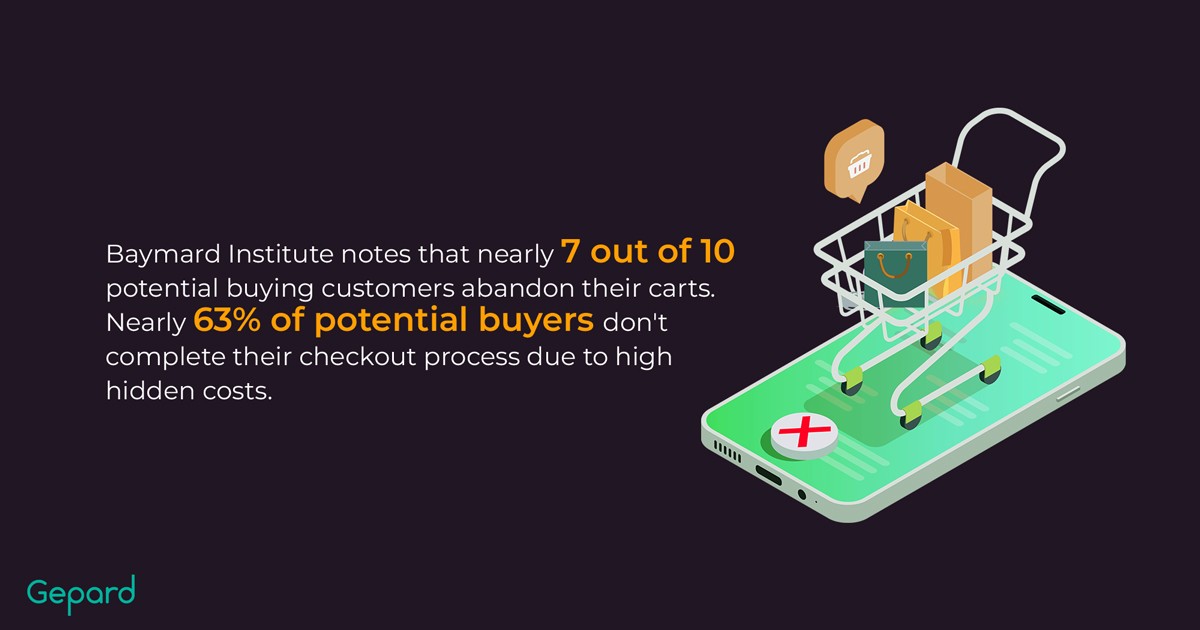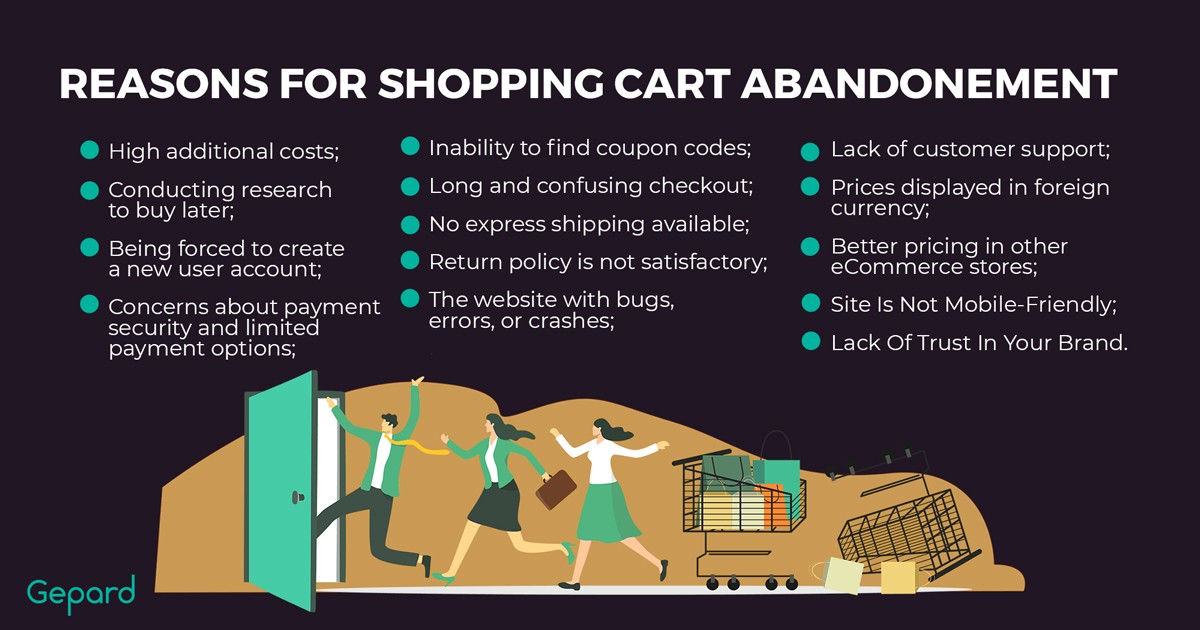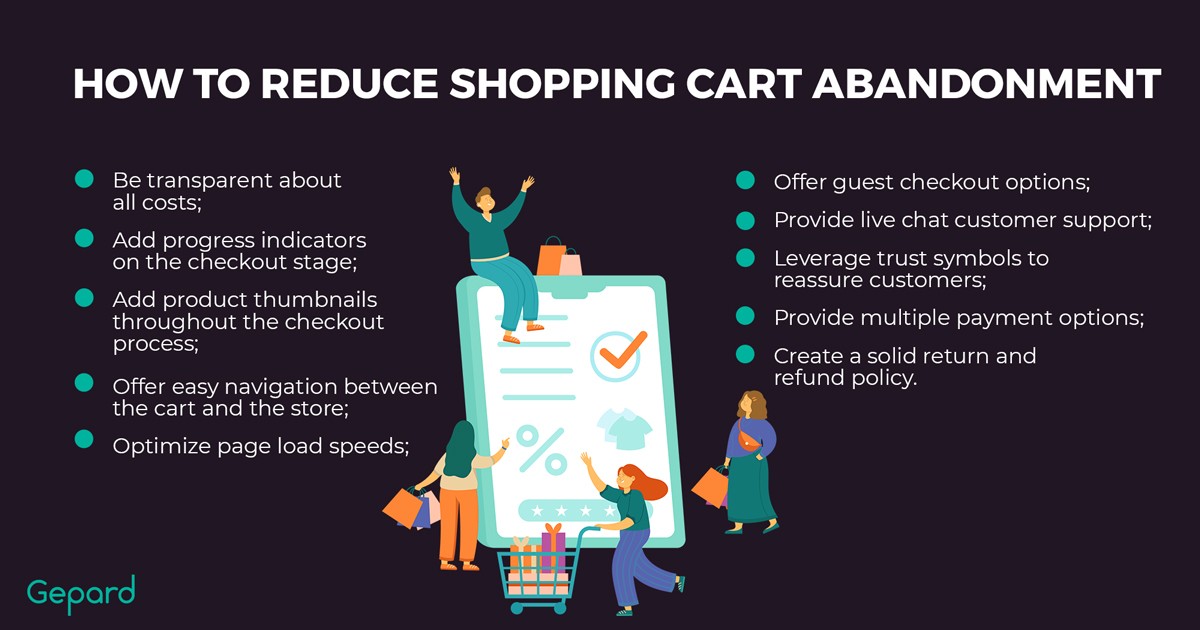How To Reduce The Shopping Cart Abandonment Rate
Shopping cart abandonment (SCA) is a headache for many e-store owners. Baymard Institute notes that nearly 7 out of 10 potential buying customers abandon their carts. Although the average shopping cart abandonment rate is about 70%, mobile users abandon up to 85.65% of their intended purchases.
These statistics are disturbing, if not frustrating for any online business owner. You spend all the resources and use the strategies at your disposal to move shoppers through the entire sales funnel and pique their interest, only to remain with more abandoned carts at the end of the day.
But here is a sigh of relief. This article highlights the whole SCA ordeal, including how to calculate the rate, why shoppers abandon their carts and how to reduce it for increased sales and revenues.
What Is A Shopping Cart Abandonment?
How To Calculate The Shopping Cart Abandonment Rate
You can calculate the shopping cart abandonment rate in your e-store to understand why shoppers have interest in your product but fail to buy.
Take the total number of complete purchases and divide it by the total number of carts created by potential buyers. After that, subtract the number you get by one and multiply that number by 100 to convert the rate into a percentage.
Here is the mathematical formula:
SCA Rate = 100 x 1- (Total Purchases/Total Carts Created).
For instance, shoppers may create 1000 carts within a period, but you only record 250 complete purchases. In that case, the rate of SCA in your store during this period will be 100 X 1-(250/1000). This is about 75%.
15 Reasons for Shopping Cart Abandonment
Do you ever wonder why potential shoppers abandon carts on your e-store? Well, here are 15 reasons.
1. High Additional Costs
Hidden and high unexpected costs are among the leading reasons why shoppers leave shopping carts. Statista found that nearly 63% of potential shoppers don’t complete their purchasing process due to this reason. Some of these additional costs may include taxes and charges for complimentary items.

2. Conducting Research To Buy Later
It’s common for shoppers to compare the price and specifications of various products in multiple stores. While doing so, a customer may add an item to the cart and move to another site to do further research. Some often come back, but that doesn’t guarantee a purchase, especially if they discover a better alternative during their research.
3. Being Forced To Create A New User Account
Consumers resort to eCommerce platforms because they want to shop conveniently. Asking them to create a new user account at the purchasing process denies them an “instant” shopping experience. Besides triggering shoppers to abandon their shopping carts, forcing users to create an account also can raise doubts about your business’ credibility, especially if creating a user account demands too many details.
4. Concerns About Payment Security
It’s understandable for any Internet user to leave a website if it raises security concerns. The same applies to digital consumers when it comes to payments. Some discrepancies during a normal purchasing process, such as missing SSL certificates, design flaws and outdated layouts may trigger a customer to abandon their shopping cart.
5. Inability To Find Coupon Codes
Businesses often use coupon codes to generate traffic and drive new shoppers to their online retail stores. If the customer visits the store but can’t find the discount coupon code they were promised, they’ll likely abandon the shopping cart immediately.
6. Long And Confusing Checkout
A long and confusing purchasing process equals a poor customer experience. Buyers want to check out on the go after spending endless hours navigating the e-store. Retailers who complicate this by adding unnecessary forms at the checkout stage often experience high rates of shopping cart abandonment. Multiple tabs that pop up during a purchasing process also can influence this.
7. No Express Shipping Available
Not all shoppers get fascinated by the “shipping within 7 days” policy that many stores advertise alongside their products. In fact, it can be a turnoff, especially when time-bound products, such as seasonal décor and birthday gifts, come into play. If shoppers notice that you can’t provide express shipping for such products, they’ll likely abandon their carts.
8. Return Policy Is Not Satisfactory
Consumers don’t have the luxury to inspect products physically before paying for them when it comes to online shopping. For this reason, many rely on return policies and warranties to cover them if a store delivers defective products or the items they didn’t order. An ambiguous or missing return policy can prompt shoppers to abandon the cart.
9. The Website Has Bugs, Errors, Or Crashes
A poorly designed e-store with rampant crashes and downtimes is a deterrent to complete purchases. Even worse, it affects the general customer experience. Websites that take too much time to load at the checkout stage can also prompt shoppers to abandon their shopping carts.
10. Lack Of Customer Support
Even with the convenience of online shopping, shoppers still want the process to be as seamless as possible. Consumers will likely abandon a shopping cart if their experience is horrible and no one is around to help them navigate the site. The consumer will still go ahead to abandon the cart if the customer service agent in line takes longer than necessary to address their concerns.

11. Limited Payment Options
Not everyone wants to pay with credit cards. In fact, while credit cards use on e-stores accounted for 27% of online payments in 2020, the use of digital wallets rose to 29.8%. These statistics indicate that consumers prefer varying payment options and they may leave shopping carts if their go-to e-store doesn’t support that.
12. Prices Displayed In Foreign Currency
Displaying prices in multiple currencies can be great if you’re serving a global target audience. However, the average consumer wants a simple price tag displayed in their local currency. Moreover, not all online shoppers have the time to convert prices into their local currency, even if they know how to do so. In that case, they’ll abandon the cart immediately.
13. Better Pricing In Other E-stores
As noted earlier, digital consumers always research products on various e-stores before opting for one. If a customer adds an item to a cart and discovers better pricing elsewhere, they’ll likely not come back.
Similarly, shoppers may leave shopping carts on other sites if your retail store offers a relatively affordable pricing model.
14. Site Is Not Mobile-Friendly
Out of the 4.95 billion people who use the internet across the globe, 91.2% of them leverage mobile devices, translating to nearly 62.5% of the planet’s population. Any eCommerce site that is not mobile-friendly will likely have these people abandoning their shopping carts. A site that isn+’t mobile-friendly may not clearly display all the items in the cart for the customer to verify.
15. Lack Of Trust In Your Brand
How shoppers perceive a business can determine whether they’ll complete their purchase or not. For instance, relatively new businesses may not exude an outstanding reputation like e-stores that have been around for a while. A customer may add items to a cart and abandon it altogether simply because they don’t trust the brand or they are just trying the shopping experience.
Check Analytics Data To Find Causes
Business owners can leverage the shopping cart abandonment rate formula discussed in this guide to determine how many shoppers don’t complete purchases in their store. However, for a more in-depth insight into the causes of the high SCA rate, it will help if you leverage a more sophisticated and automated software, such as Google Analytics.
Google Analytics is free and helps you track website traffic and visitor behavior. For instance, you can create funnels and follow the customer’s entire journey, right from the moment they enter your site to determine where problems arise before they complete the purchasing process.
Even better, you can leverage a reliable data integration tool for large-scale analytics data. Tools like integrate.io may help link the entire analysis to a single dashboard, making it much easier to pinpoint problems.
How To Reduce Shopping Cart Abandonment
Shopping basket or cart abandonment—it doesn’t matter what you call it, is a frustrating ordeal for many online retailers, especially when it doesn’t seem to stop. Although it’s inevitable that not all shoppers visit your store as buying consumers, here are some proven ways of reducing shopping cart abandonment.
Be Transparent About All Costs
Do you show your customer how you arrive at the final purchasing price? It’s a standard practice for eCommerce platforms to display total order costs upfront. However, some charges, such as delivery costs, may be challenging to estimate due to location variations. In that case, it will help if you include a shipping cost calculator for shoppers to deduce near-accurate charges. This makes you look more transparent as opposed to just including a random cost.
Add Progress Indicators On The Checkout Stage
A typical checkout prompt can turn into a long and frustrating process, especially when shoppers are integrating their payment option. It will help if you include progress indicators at the checkout stage for consumers to understand what they are doing and how far they are from completing the full purchasing process.
Add Product Thumbnails Throughout The Purchasing Process
Although shoppers know exactly what they add to shopping carts, they still appreciate a persistent reminder of their cart contents throughout the purchasing process. Thumbnails featuring product images and prices throughout the purchasing process reassure shoppers of their picks in terms of quantity, size or even color. This enhances their shopping experience and encourages them to complete the purchasing process.
Easy Navigation Between The Cart And The Store
Shoppers often leave carts after adding items to go back to the site and browse for more products. Sometimes, they also add one item at a time, especially when creating an end-of-month wish list. It should be easy for consumers to leave their carts, go back to the store and still return to find the previously added products intact. That said, provide an option to save cart contents and more shoppers will complete their intended purchases.
Optimize Page Load Speeds
Optimize your site for pages to load faster on different browsers, whether PC or mobile-based. Shoppers want to complete the purchasing process faster and start tracking their order delivery. A site that loads pages seamlessly enhances the overall customer experience, which is what you need to encourage visitors to buy more. Also, lest you forget, most of your shoppers will be accessing your site via mobile phones, so optimize it to be mobile-centric.
Offer Guest Checkout Options
A prompt that requires shoppers to create and register an account using their personal information before a purchasing process is a barrier to completing purchases. You can solve this by including a guest purchasing process, especially on basic commodities, such as grocery supplies. In this case, shoppers can create a user account anytime they feel free to do so, not necessarily when checking out.
Give Live Chat Customer Support
Customer support services allow you to provide help whenever shoppers need it. Navigating the checkout fields may not be easy for everyone, especially first-time shoppers. Instead of offering explanatory texts, a live customer care agent can resolve the issue quickly and to the customer’s satisfaction, encouraging them to complete the purchase. Even better, you can also include call-back options.
Leverage Trust Symbols To Reassure Shoppers
Use trust symbols that reassure shoppers about your brand’s credibility and the eCommerce site’s security. For instance, you can display security trust marks from renowned brands, such as Norton and Verisign, to increase consumer confidence in your data products. You also can boost your brand’s credibility by displaying respective trust symbols and certifications. All this encourages shoppers to complete the purchasing process.
Provide Multiple Payment Options
List and support all the payment options at the checkout stage and encourage shoppers to select their most preferred choice. Also, you shouldn’t have a mandatory payment option for select goods. If possible, some consumers might also appreciate paying for faster delivery of the purchased items. It’s all about knowing the different payment preferences by consumers and integrating them in your e-store to encourage more complete purchases.
Create A Solid Return And Refund Policy
Show your shoppers that you care about their experience beyond the checkout stage by creating a solid return and refund policy for all purchases. For instance, an electronic product should have a pretty flexible return policy, say 30 days since shoppers need more time to spot any quality inconsistencies. For fairly priced items, create an unconditional refund policy if shoppers deem them defective after purchase. This will encourage consumers to complete the purchasing process because you’re reassuring them of the value for their money.

Shopping Cart Integration With PIM Software
Product information management (or PIM) software makes integration with multiple eCommerce sites and shopping carts easier, faster and relatively affordable. Moreover, shopping cart integration with PIM software complements other omnichannel services. You can also do the following if you integrate with a PIM solution:
1. Shop Integration With Multiple Marketplaces
You’ll create a seamless omnichannel experience with PIM software integration by connecting to multiple marketplaces. This gives you access to a wider target audience, bringing in more orders and complete purchases.
2. Exchange Product Listings
PIM integration helps you exchange product listings and introduce new offers to your store faster, thanks to the connection with external databases. That way, you can download product data feeds, optimize them and post them on the store’s website.
3. Product Data Syndication
With PIM software, you can syndicate product information to other marketplace listings, such as Amazon, eBay and Etsy. That way, you can synchronize product data across multiple channels while also complying with the requirements of every sales portal.
4. Product Specifications Management
With a central product database, PIM integration enables easier product specifications management, where you can work on product descriptions faster. This allows you to position your products on the web for better visibility and more orders.
5. Add And Update Localized Product Information To Online Shops
A PIM solution allows you to add and update various localized product information to online shops, such as translated product descriptions. You can also access merchant info, such as language, currency and time zone. Doing so enhances the overall customer experience for more complete purchases.
Shopping Cart Abandonment FAQ
Why Is SCA A Problem For Retailers?
Shopping cart abandonment stalls growth, revenues and business goals by hindering complete purchases. The primary goal for any retailer is to stimulate sales.
What Is The Fastest Way To Reduce SCA Rate?
The fastest way to reduce the rate at which potential buyers leave shopping carts in your e-store is by improving the overall user experience. This can include optimizing the site to be more intuitive and providing customer care services to offer assistance whenever shoppers need it.
Where Should I Start If My Shopping Cart Abandonment Rate Is Rapidly Growing?
Start by leveraging Google analytics data to understand the buying journey of your shoppers and the possible causes of the increasing SCA rate. Getting insights into this information allows you to tackle every problem individually.
What’s Next?
Reducing the rate at which shoppers leave shopping carts in your retail store is essential if you’re going to make more sales and realize your business’ overarching goals. Remember, a business should encourage its shoppers to complete their purchases. The average consumer wants a buying system that works on the go.
Gepard is your go-to service provider for end-to-end product data syndication. This allows setting up and running everything automatically on behalf of e-stores. With full, standby support from Gepard, you can rest assured that your e-store benefits from all the necessary product adjustments to drive sales. Moreover, our data validation solution makes your data output clean and consistent for spotting any errors.
Contact us today to request a personalized demo and see how Gepard can be of assistance.





